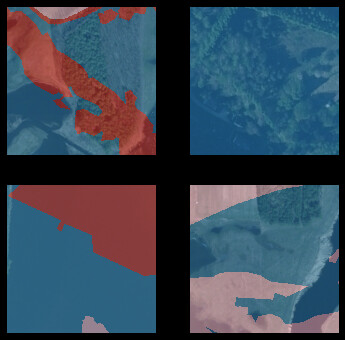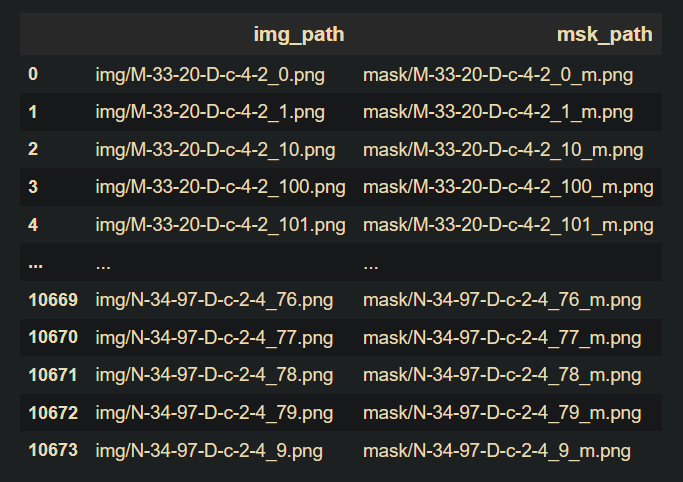The summary report looks good. So, I’m not sure what is going on.
Setting-up type transforms pipelines
Collecting items from img_path
0 C:\Maxwell_Data\landcover\output\img\M-33-20-D-c-4-2_0.png
1 C:\Maxwell_Data\landcover\output\img\M-33-20-D-c-4-2_1.png
2 C:\Maxwell_Data\landcover\output\img\M-33-20-D-c-4-2_10.png
3 C:\Maxwell_Data\landcover\output\img\M-33-20-D-c-4-2_100.png
4 C:\Maxwell_Data\landcover\output\img\M-33-20-D-c-4-2_101.png
… …
10669 C:\Maxwell_Data\landcover\output\img\N-34-97-D-c-2-4_76.png
10670 C:\Maxwell_Data\landcover\output\img\N-34-97-D-c-2-4_77.png
10671 C:\Maxwell_Data\landcover\output\img\N-34-97-D-c-2-4_78.png
10672 C:\Maxwell_Data\landcover\output\img\N-34-97-D-c-2-4_79.png
10673 C:/Maxwell_Data/landcover/output/img/N-34-97-D-c-2-4_9.png
msk_path
0 C:\Maxwell_Data\landcover\output\mask\M-33-20-D-c-4-2_0_m.png
1 C:\Maxwell_Data\landcover\output\mask\M-33-20-D-c-4-2_1_m.png
2 C:\Maxwell_Data\landcover\output\mask\M-33-20-D-c-4-2_10_m.png
3 C:\Maxwell_Data\landcover\output\mask\M-33-20-D-c-4-2_100_m.png
4 C:\Maxwell_Data\landcover\output\mask\M-33-20-D-c-4-2_101_m.png
… …
10669 C:\Maxwell_Data\landcover\output\mask\N-34-97-D-c-2-4_76_m.png
10670 C:\Maxwell_Data\landcover\output\mask\N-34-97-D-c-2-4_77_m.png
10671 C:\Maxwell_Data\landcover\output\mask\N-34-97-D-c-2-4_78_m.png
10672 C:\Maxwell_Data\landcover\output\mask\N-34-97-D-c-2-4_79_m.png
10673 C:/Maxwell_Data/landcover/output/mask/N-34-97-D-c-2-4_9_m.png
[10674 rows x 2 columns]
Found 10674 items
2 datasets of sizes 8540,2134
Setting up Pipeline: ColReader – {‘cols’: 0, ‘pref’: ‘’, ‘suff’: ‘’, ‘label_delim’: None} -> PILBase.create
Setting up Pipeline: ColReader – {‘cols’: 1, ‘pref’: ‘’, ‘suff’: ‘’, ‘label_delim’: None} -> PILBase.create
Building one sample
Pipeline: ColReader – {‘cols’: 0, ‘pref’: ‘’, ‘suff’: ‘’, ‘label_delim’: None} -> PILBase.create
starting from
img_path C:\Maxwell_Data\landcover\output\img\N-33-139-C-d-2-2_4.png
msk_path C:\Maxwell_Data\landcover\output\mask\N-33-139-C-d-2-2_4_m.png
Name: 7065, dtype: object
applying ColReader – {‘cols’: 0, ‘pref’: ‘’, ‘suff’: ‘’, ‘label_delim’: None} gives
C:\Maxwell_Data\landcover\output\img\N-33-139-C-d-2-2_4.png
applying PILBase.create gives
PILImage mode=RGB size=512x512
Pipeline: ColReader – {‘cols’: 1, ‘pref’: ‘’, ‘suff’: ‘’, ‘label_delim’: None} -> PILBase.create
starting from
img_path C:\Maxwell_Data\landcover\output\img\N-33-139-C-d-2-2_4.png
msk_path C:\Maxwell_Data\landcover\output\mask\N-33-139-C-d-2-2_4_m.png
Name: 7065, dtype: object
applying ColReader – {‘cols’: 1, ‘pref’: ‘’, ‘suff’: ‘’, ‘label_delim’: None} gives
C:\Maxwell_Data\landcover\output\mask\N-33-139-C-d-2-2_4_m.png
applying PILBase.create gives
PILMask mode=L size=512x512
Final sample: (PILImage mode=RGB size=512x512, PILMask mode=L size=512x512)
Collecting items from img_path
0 C:\Maxwell_Data\landcover\output\img\M-33-20-D-c-4-2_0.png
1 C:\Maxwell_Data\landcover\output\img\M-33-20-D-c-4-2_1.png
2 C:\Maxwell_Data\landcover\output\img\M-33-20-D-c-4-2_10.png
3 C:\Maxwell_Data\landcover\output\img\M-33-20-D-c-4-2_100.png
4 C:\Maxwell_Data\landcover\output\img\M-33-20-D-c-4-2_101.png
… …
10669 C:\Maxwell_Data\landcover\output\img\N-34-97-D-c-2-4_76.png
10670 C:\Maxwell_Data\landcover\output\img\N-34-97-D-c-2-4_77.png
10671 C:\Maxwell_Data\landcover\output\img\N-34-97-D-c-2-4_78.png
10672 C:\Maxwell_Data\landcover\output\img\N-34-97-D-c-2-4_79.png
10673 C:/Maxwell_Data/landcover/output/img/N-34-97-D-c-2-4_9.png
msk_path
0 C:\Maxwell_Data\landcover\output\mask\M-33-20-D-c-4-2_0_m.png
1 C:\Maxwell_Data\landcover\output\mask\M-33-20-D-c-4-2_1_m.png
2 C:\Maxwell_Data\landcover\output\mask\M-33-20-D-c-4-2_10_m.png
3 C:\Maxwell_Data\landcover\output\mask\M-33-20-D-c-4-2_100_m.png
4 C:\Maxwell_Data\landcover\output\mask\M-33-20-D-c-4-2_101_m.png
… …
10669 C:\Maxwell_Data\landcover\output\mask\N-34-97-D-c-2-4_76_m.png
10670 C:\Maxwell_Data\landcover\output\mask\N-34-97-D-c-2-4_77_m.png
10671 C:\Maxwell_Data\landcover\output\mask\N-34-97-D-c-2-4_78_m.png
10672 C:\Maxwell_Data\landcover\output\mask\N-34-97-D-c-2-4_79_m.png
10673 C:/Maxwell_Data/landcover/output/mask/N-34-97-D-c-2-4_9_m.png
[10674 rows x 2 columns]
Found 10674 items
2 datasets of sizes 8540,2134
Setting up Pipeline: ColReader – {‘cols’: 0, ‘pref’: ‘’, ‘suff’: ‘’, ‘label_delim’: None} -> PILBase.create
Setting up Pipeline: ColReader – {‘cols’: 1, ‘pref’: ‘’, ‘suff’: ‘’, ‘label_delim’: None} -> PILBase.create
Setting up after_item: Pipeline: AddMaskCodes -> ToTensor
Setting up before_batch: Pipeline:
Setting up after_batch: Pipeline: IntToFloatTensor – {‘div’: 255.0, ‘div_mask’: 1}
Building one batch
Applying item_tfms to the first sample:
Pipeline: AddMaskCodes -> ToTensor
starting from
(PILImage mode=RGB size=512x512, PILMask mode=L size=512x512)
applying AddMaskCodes gives
(PILImage mode=RGB size=512x512, PILMask mode=L size=512x512)
applying ToTensor gives
(TensorImage of size 3x512x512, TensorMask of size 512x512)
Adding the next 3 samples
No before_batch transform to apply
Collating items in a batch
Applying batch_tfms to the batch built
Pipeline: IntToFloatTensor – {‘div’: 255.0, ‘div_mask’: 1}
starting from
(TensorImage of size 4x3x512x512, TensorMask of size 4x512x512)
applying IntToFloatTensor – {‘div’: 255.0, ‘div_mask’: 1} gives
(TensorImage of size 4x3x512x512, TensorMask of size 4x512x512)

